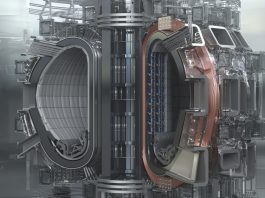The UK Atomic Energy Authority (UKAEA) has announced groundbreaking progress in its £200m Lithium Breeding Tritium Innovation (LIBRTI) programme.
This fusion fuel initiative is a key component of the UK’s strategy to develop sustainable fusion energy.
Backed by the Department for Energy and Net Zero, this project forms part of the nation’s broader Fusion Futures programme, targeting advancements in fusion fuel technology and industrial capacity by 2025/2026.
Pioneering fusion fuel: LIBRTI’s vision
Fusion energy relies on the hydrogen isotopes deuterium and tritium. While deuterium is abundant and can be extracted from seawater, tritium’s limited availability presents a significant challenge.
LIBRTI addresses this by advancing methods for controlled tritium production, or ‘breeding,’ using a lithium-containing blanket that surrounds the fusion reaction.
The breeder blanket performs three critical roles:
- Tritium production: Reacting with high-energy neutrons from the fusion reaction to generate tritium.
- Heat absorption: Capturing and utilising the heat produced during fusion for energy generation.
- Shielding components: Protecting reactor machinery from radiation damage.
By enabling a continuous tritium supply, this innovation supports the creation of self-sustaining fusion power plants, bringing the promise of limitless clean energy closer to reality.
Building the testbed: Culham Campus at the forefront
A new testbed facility at Culham Campus in Oxfordshire will anchor the LIBRTI programme.
Central to this facility will be a neutron source provided by SHINE Technologies, US, in 2027.
This 14 mega electron volt (MeV) deuterium-tritium fusion system will drive research into tritium breeding and fusion fuel cycle advancements.
Greg Piefer, CEO of SHINE Technologies, explained: “Our partnership with UKAEA’s LIBRTI program is a key milestone for fusion energy.
“Today, our systems are already achieving up to 50 trillion fusion reactions per second, which makes them the world’s brightest steady-state deuterium-tritium neutron sources.
“These fusion spectrum neutrons are essential to validate tritium breeding materials critical for scalable fusion energy systems.
“We’re excited to work with UKAEA to develop next-generation fusion solutions to help pave the way to clean, abundant energy.”
To bolster this initiative, UKAEA has committed £9m to fund 12 small-scale experiments and digital simulation projects, running until March 2026.
Collaborative projects advancing fusion fuel
The LIBRTI programme brings together a diverse network of researchers, universities, and private enterprises, fostering innovation across multiple fronts.
The 12 funded projects include:
| Project Name | Lead Organisation |
| Development of a Liquid Lithium Digital Twin | Amentum Clean Energy Limited |
| Studying the adequacy of 6LiD as a solid breeder material | Astral Neutronics Ltd |
| TRIMAX (Tritium reactor integrated analysis experiment, multiphysics code) | Bangor University – Nuclear Futures Institute |
| Correlation of scaled mock-ups to full-scale using multiphysics | IDOM UK Limited |
| TRI-PRISM (tritium permeation real-time in-line sensor for monitoring) | Kyoto Fusioneering |
| TriBreed (using High Flux neutron source facility at the University of Birmingham) | Lancaster University |
| Breeder Agnostic Tritium Inventory Digital Twin System | Materials, University of Manchester |
| Develop openTBB (Tritium Breeding Blanket) – multiphysics transport simulation | US university |
| VICE (Quantification of uncertainties in tritium breeding in ceramics, manufacturing and testing) | Oxford Sigma |
| Experimental programme including lithium impurity control, diagnostics and irradiation testing | Tokamak Energy |
| Develop a small solid lithium ceramic breeder with in-line tritium detection capability for calibrated neutron sources | University of Birmingham |
| Tritium breeding in FLiBe | University of Edinburgh |
Digital innovation: Transforming fusion design
A cornerstone of LIBRTI’s approach is its digital platform, integrating Building Information Management (BIM) systems with multiphysics simulation models.
This platform allows for precise performance replication and optimisation, supporting the design and validation of future breeder systems.
Amanda Quadling, Executive Director for Fusion Fundamental Research and Materials Science at UKAEA, and Senior Responsible Owner for LIBRTI, added: “We aim to move from a science experiment to providing the supply chain with the confidence needed to support future fusion power plants.
“The engineering scale experimental results combined with a robust digital platform offer powerful ways to design and substantiate future breeder systems for industrial use.”
A new era for fusion fuel
The LIBRTI programme demonstrates the UK’s leadership in advancing fusion energy, offering solutions to the challenges of tritium scarcity and breeder system design.
With international collaboration and cutting-edge research, fusion fuel is becoming a tangible pathway to a clean, sustainable energy future.









